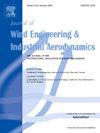开放树木的平均和最大二维风力
IF 4.9
2区 工程技术
Q1 ENGINEERING, CIVIL
Journal of Wind Engineering and Industrial Aerodynamics
Pub Date : 2025-02-01
DOI:10.1016/j.jweia.2024.105966
引用次数: 0
摘要
对树木风荷载的准确量化是估算树木损害风险的关键。在这里,我们提出了一个实验量化的风力对农村,开放生长,落叶树。我们首先证明了二维力矢量的振幅和方向可以使用安装在阀杆底部的两个应变片来估计。其次,我们证明了树沿平均风向的动力响应与横向方向的动力响应存在差异,表明研究这两个力分量的重要性。随后,重点分析了在较宽风速范围内的平均风速和最大风速。在冬季,平均和最大风速都是由二次风速依赖来描述的,而在夏季,需要进行调整以考虑叶片的重新配置。这个调整是用同样的函数关系来参数化平均和最大的力。总体而言,在4 ~ 11 ms−1风速范围内,夏季和冬季的最大风荷载分别比平均值大49% ~ 66%和52% ~ 79%。本文章由计算机程序翻译,如有差异,请以英文原文为准。
Mean and maximum two dimensional wind force on an open-grown tree
The accurate quantification of the wind loading on trees is crucial for estimating the risk of tree damage. Here, we present an experimental quantification of the wind force on a rural, open-grown, deciduous tree. We first demonstrate that the amplitude and direction of the two-dimensional force vector can be estimated using two strain gauges mounted on the bottom of the stem. Secondly, we show that the dynamic response of the tree along the mean wind direction shows differences from that in the transverse direction, indicating the importance of studying both force components. Subsequently, the analysis is focused on the mean and maximum wind force over a wide wind speed range. During winter, both the mean and maximum force is described by a quadratic wind speed dependence, whereas during summer, an adjustment is needed to account for the reconfiguration of the leaves. This adjustment is parameterized using the same functional relationship for the mean and maximum force. Overall, in the wind speed range between 4–11 ms−1 the maximum wind load was 49%–66% and 52%–79% larger than the mean, during the summer and winter, respectively.
求助全文
通过发布文献求助,成功后即可免费获取论文全文。
去求助
来源期刊
CiteScore
8.90
自引率
22.90%
发文量
306
审稿时长
4.4 months
期刊介绍:
The objective of the journal is to provide a means for the publication and interchange of information, on an international basis, on all those aspects of wind engineering that are included in the activities of the International Association for Wind Engineering http://www.iawe.org/. These are: social and economic impact of wind effects; wind characteristics and structure, local wind environments, wind loads and structural response, diffusion, pollutant dispersion and matter transport, wind effects on building heat loss and ventilation, wind effects on transport systems, aerodynamic aspects of wind energy generation, and codification of wind effects.
Papers on these subjects describing full-scale measurements, wind-tunnel simulation studies, computational or theoretical methods are published, as well as papers dealing with the development of techniques and apparatus for wind engineering experiments.

 求助内容:
求助内容: 应助结果提醒方式:
应助结果提醒方式:


